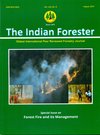Fires in Agroforests - A Case Study of Poplar Based Agroforestry
DOI:
https://doi.org/10.36808/if/2017/v143i8/118975Keywords:
Agroforests, Fire, Causes, Damage, Control measures, PBAF.Abstract
Agroforests are the major source of wood production in India and also suffer damage from fires like forests. There are numerous causes of fire viz., burning of agriculture waste and left over tree parts inside and around agroforests, spread of fire from burning of agricultural residues from the adjoining fields, accidental fires due to spark in transmission lines and machinery operated on farm land, mischief by others etc. The paper presents a case study of poplar based agroforestry (PBAF) which is extensively practiced in the Indo-Gangetic plains of northwestern states. Poplar is highly sensitive to fires and it is affected even formdistant fire flames. The damage varies from a little check on growth of trees/saplings to complete mortality of trees and damage to agriculture crops. Fires damage to PBAF could be controlled by safe disposal of agriculture residue from within and around agroforests, creating a deep ploughed fire line between agroforests and adjoining fields where agriculture residue is put on fire, counter firing from the side of agroforests, ploughing crop a little away from the fire to save the rest of the agroforests, hiring fire tenders and beating the fire with green foliage.References
Andreae M.O., Artaxo P., Fischer H., Freitas S.R., Gregoire J.M., Hansel A., Hoor P., Kormann R., Krejci R., Lange L., Lelieveld L., Lindinger W.,
Longo K., Peters W., de Reus M., Scheeren B., silva Dias M.A.F., Strom J., van Velthoven P.F.L. and Williams J. (2001). Transport of biomass burning smoke to the upper troposphere by deep convection in the Equitorial Region. Geophys. Res. Lett., 28: 951-954.
Anon. (2006). The Punjab Preservation of Sub soil Water Act. 22nd April 2006. Government of Punjab
Anon. (2009). The Haryana Preservation of Sub soil Water Act. March 18, 2009, Government of Haryana.
Chang D. and Song Y. (2010). Estimates of biomass burning emissions in tropical Asia based on satellite derived data. Atmos. Chem. Phy.,10: 2335-2351.
Dhiman R.C. (2012). Status of poplar culture in India. ENVIS Forestry Bulletin. 12(1):15-32.
Dhiman R.C. (2013). Status and impact of commercial agroforestry in India. Indian J. Agroforestry,15(2):55-67.
Dhiman R.C. (2015). Review and revision of the National Forest Policy. Ply GazetteDec 2015 pp.89-100. Hindi (125-126).
Gadde B., Christoph M.C. and Wassmann R. (2009). Rice straw as a renewable energy source in India, Thailand, and the Philippines: Overall potential and limitations for energy contribution and greenhouse gas mitigation. Biomass Bioenergy,33: 1532–1546.
Gupta R.K, Narsh R.K., Hobbs P.R., Jiaguo Z. and Ladha J.K. (2003). Sustainability of post –green revolution agriculture: The rice-wheat cropping systems of the Indo-Gangetic plains and China- Improving the productivity and sustainability of rice wheat systems: Issues and Impact. ASA Special Publication, Wisconsin, USA, 65.
IPCC (2006). (Intergovernmental Panel on Climate Change) Guidelines for national greenhouse gas inventories (IGES, Japan) (www.ipcc.ch), 430.
Jain N., Bhatia A. and Pathak H. (2014). Emission of air pollutants from crop residue burning in India. Aerosol and Air Quality Research, 14: 422.-430.
Kumar D. and Dhiman R.C. (2015). Country report on poplars and willows period: 2012-2015. IPC (FAO) (http://www.fao.org/forestry/44756-09ec50609435431af805e892765a686e3.pdf).
Luna R.K. (2007). Principles and Practices of Forest Fire Control. International Book Distributors,Dehreadun.
Downloads
Downloads
Published
How to Cite
Issue
Section
License
Unless otherwise stated, copyright or similar rights in all materials presented on the site, including graphical images, are owned by Indian Forester.





